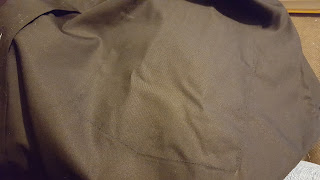Materials:
Store bought shirt for base
Fabric the length of your shirt
Piping in a matching color
Paper for making a template
This is the shirt I started with. He would have prefered a short sleeved but we couldn't find one and were running out of time. I also looked for one without a pocket but that was even harder to find. So
So the first step was to iron the shirt and also remove the pocket. It came off fairly easily but you can still see where the stitching was.
The next thing I did was make a template for the panels I wanted to add. I started by making a copy of one side of the shirt. I folded the paper to mark the curves along the neck and sleeve.
Then I used a ruler to mark the area I wanted to cover with the fabric. The stripe I made was 6 inches wide. I decided on that measurement in part because it let me avoid all the curves while still covering the pocket marks.
Trace around the template about a half inch out so that you have extra for seam allowance.
Then flip the template over to cut fabric for the other side. Be sure place the top at the same point so both sides match.
Iron the seam allowance to the back of each piece.
Pin it in place on the front of the shirt making sure it lines up evenly with the center edge. I used a ruler to be sure I have the same amount of space all the way down. Pin the piping in under the center edge, carefully tucking the top end under the seam.
Sew around the top and sides keeping the needle as close to the edge as possible.
The final step is to finish the bottom hem. Trim off most of the excess fabric. Fold the end over twice, hiding the unfinished edge inside the fold and iron. Again be sure to tuck in the end of the piping.
Sew the hem in place and you are done. Enjoy your shirt!
















No comments:
Post a Comment